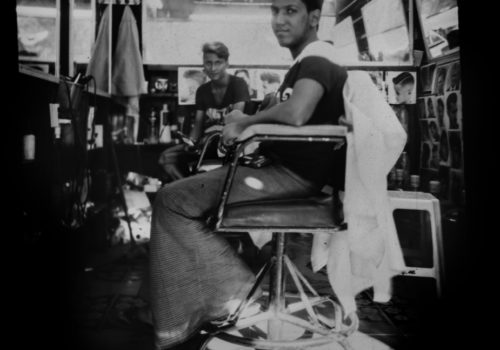A few days before the opening of the Yangon Photo Festival, the French photographer Landry Dunand, accompanied by his Afghan box camera, travelled up and down the streets of the Burmese capital to photograph its inhabitants. From March 1st to 3rd he shot photographs in black and white on his stand in Maha Bandula Park, offering curious visitors the chance to have their portraits taken with a camera obscura.
The adventure started about a dozen years ago when Landry bought his camera obscura from a shop in Kabul. There was about a dozen of them in the streets of the Afghan capital, to supply Afghans with identity photos for official documents.
The thing is made of wood and weighs close to 17 kilos. It’s equipped with a lens from a Russian enlarger from the 1970s, and looks like a pin-hole camera, that’s to say a box in which one of the faces is pierced with a hole that lets in the light. On the surface opposite this opening an upside-down image of the external subject is formed, and this is captured on photographic paper. Like the eye, the pin-hole camera captures images that are the inverse of what is seen.
Because of the small size of the hole that allows the light to pass through to the interior of the camera, the time required to make an impression on the photosensitive surface is relatively long. Depending on the size of the camera and the aperture, it can be counted in seconds or even hours.
Landry managed to take his portraits with an exposure time of around a second, dependant on the light. Nevertheless, each image needs several minutes of prior preparation. The longest stage being the finding of a subject, “The people are very open in Yangon, it’s almost impossible to photograph the women, they wouldn’t dare pose. But the atmosphere, the dust of the streets, the Burmese features, and their clothing go perfectly with the style of the camera. It’s like a machine that goes back in time”, he declared.
Along the city’s railway lines, or inside the picturesque markets, the same scene plays out: the men stop around the strange object, while the women observe from afar, with an amused eye.
As soon as one passer-by agrees to pose, the spectators gather. The pivotal moment of the operation begins: to make a sometimes unbelieving public wait. Many try to see and understand what is going on behind the hole in the black box. “Would you like to see? Come closer!.” And Landry, with the manner of a confident magician, invites the most curious to discover the interior. To everyone’s surprise, there is nothing inside the box! Nothing, not quite. For the foolhardy, the eye stuck to the camera’s opening, it’s an upside-down image of reality which presents itself. The smiles play over the faces, the attention grows around this travelling show.
In fact. Landry uses this precious time as a distraction to set up his photographic installation (inserting the paper into the camera, aiming the camera) before declaring a few minutes later, “Bravo, the photo is shot!” to mark the end of the trick. Laughter, sometimes applause, thanks this photographic sorcerer.
A new experience, which can appear anachronistic – in view of the many smartphones brandished to record the performance – but that is an elegy to slowness, to the old and to the practice of craftsmanship… so precious in a society where great speed is of the essence.
Aline Deschamps
Aline Deschamps is a journalist, photographer, and a cultural project manager working in Paris and Bangkok.
9th Yangon Photo Festival
Yangon, Burma
http://www.yangonphoto.com
http://www.facebook.com/yangonphotofestival
Landry Dunand’s work can be found at:
www.landrydunand.com
To discover more about the Afghan camera (and know how to make one):
www.afghanboxcamera.com
















